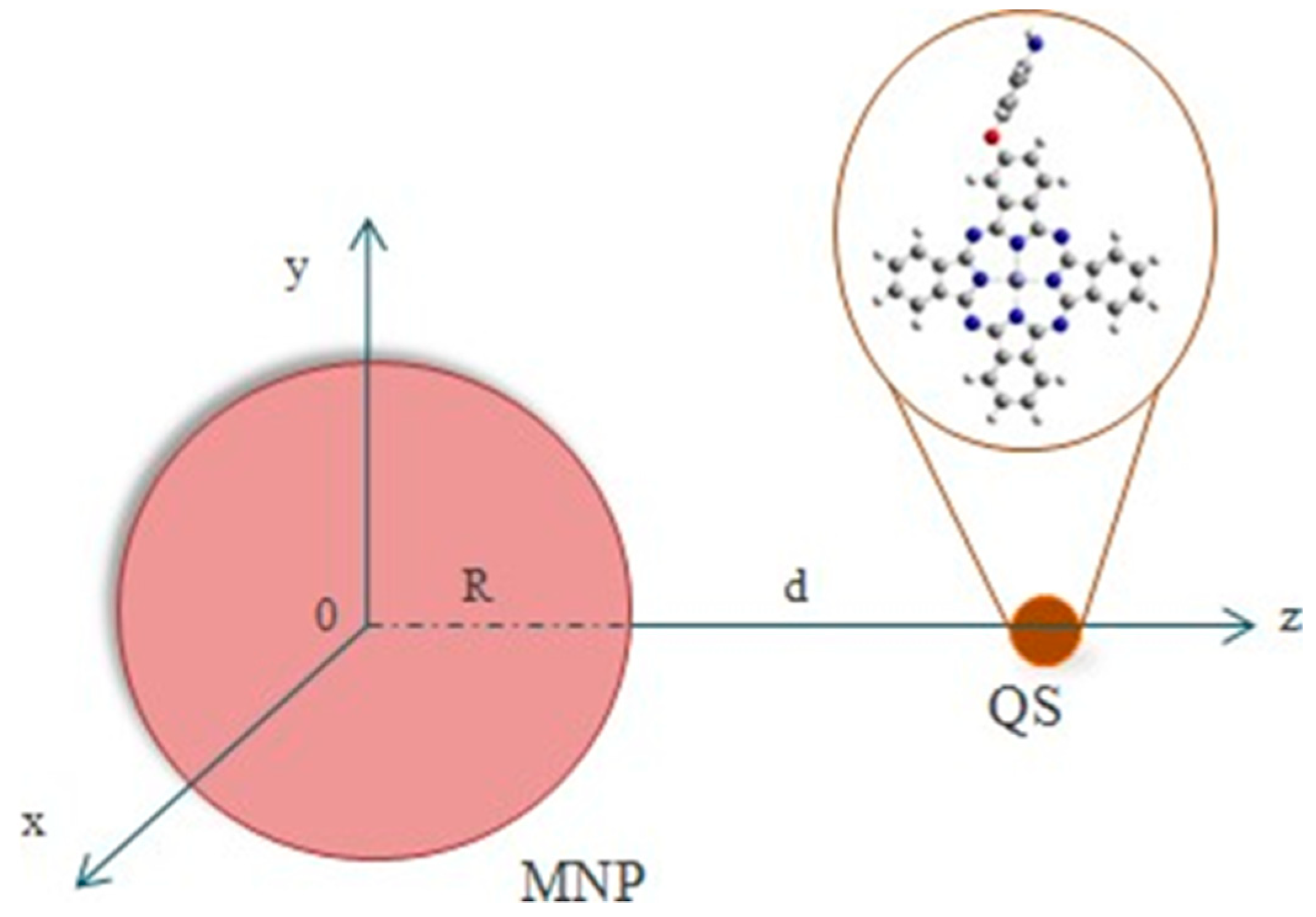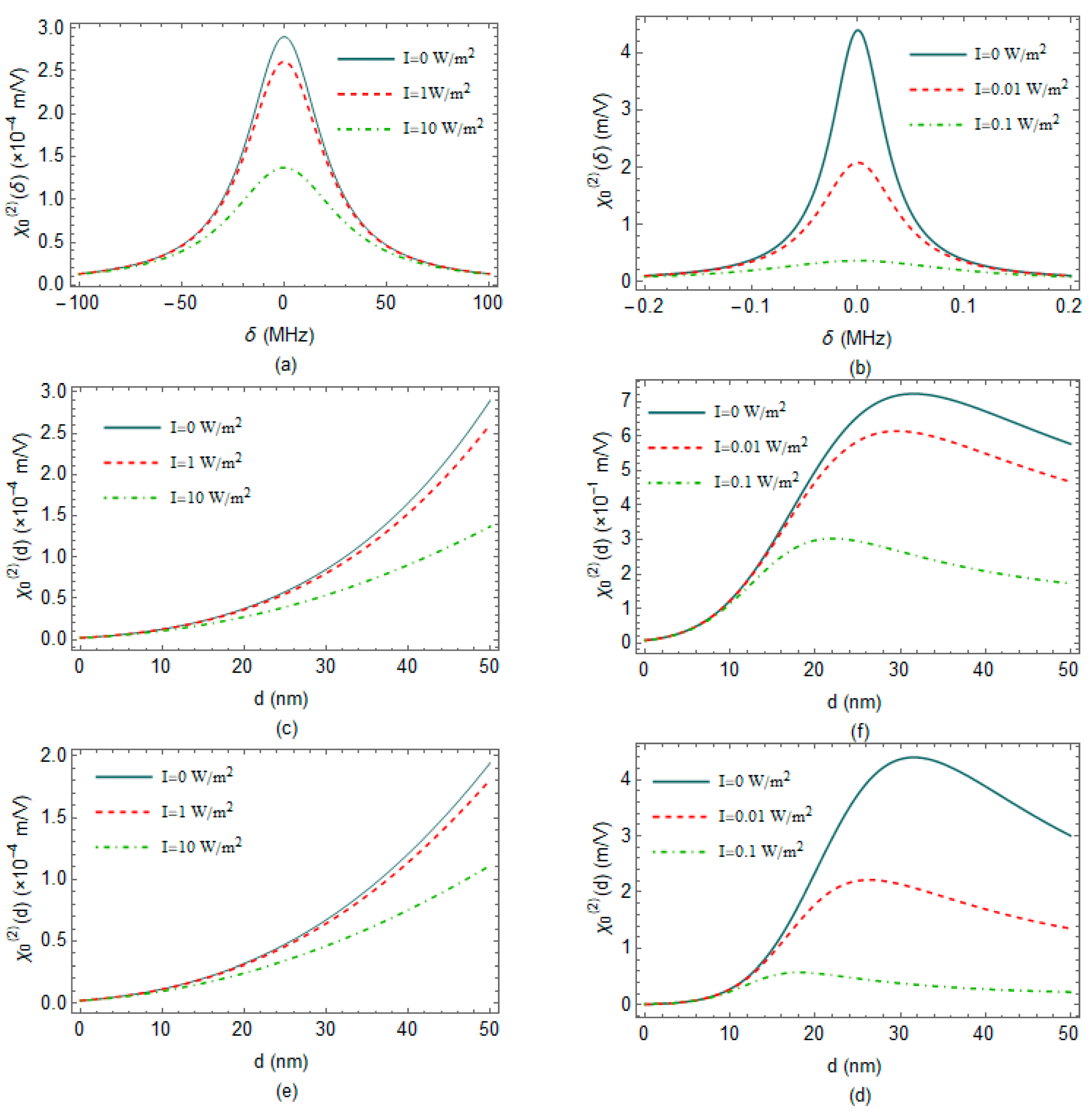Nonlinear Optical Rectification in a Polar Molecule-Plasmonic Nanoparticle Structure †
Abstract
:1. Introduction
2. Theoretical Model
3. The Zinc-Phthalocyanine Molecular Complex
4. Results and Discussion
5. Summary
Author Contributions
Conflicts of Interest
Abbreviations
| QS | quantum system |
| MNP | metal nanoparticle |
| PDM | permanent dipole moment |
| NOR | nonlinear optical rectification |
References
- Singh, M.R. Enhancement of the second-harmonic generation in a quantum dot-metallic nanoparticle hybrid system. Nanotechnology 2013, 24, 125701. [Google Scholar] [CrossRef] [PubMed]
- Evangelou, S.; Angelis, C.T. Using the Purcell effect for the modification of third-harmonic generation in a quantum dot near a metallic nanosphere. Opt. Commun. 2019, 447, 36–41. [Google Scholar] [CrossRef]
- Evangelou, S.; Yannopapas, V.; Paspalakis, E. Modification of Kerr nonlinearity in a four-level quantum system near a plasmonic nanostructure. J. Mod. Opt. 2014, 61, 1458–1464. [Google Scholar] [CrossRef]
- Kosionis, S.G.; Paspalakis, E. Control of Self-Kerr Nonlinearity in a Driven Coupled Semiconductor Quantum Dot—Metal Nanoparticle Structure. J. Phys. Chem. C 2019, 123, 7308–7317. [Google Scholar] [CrossRef]
- Paspalakis, E.; Evangelou, S.; Kosionis, S.G.; Terzis, A.F. Strongly modified four-wave mixing in a coupled semiconductor quantum dot-metal nanoparticle system. J. Appl. Phys. 2014, 115, 083106. [Google Scholar] [CrossRef]
- Carreño, F.; Antón, M.A.; Paspalakis, E. Nonlinear optical rectification and optical bistability in a coupled asymmetric quantum dot-metal nanoparticle hybrid. J. Appl. Phys. 2018, 124, 113107. [Google Scholar] [CrossRef]
- Thanopulos, I.; Paspalakis, E.; Yannopapas, V. Plasmon-induced enhancement of nonlinear optical rectification in organic materials. Phys. Rev. B 2012, 85, 035111. [Google Scholar] [CrossRef]
- Carreño, F.; Antón, M.A.; Yannopapas, V.; Paspalakis, E. Resonance fluorescence spectrum of a Λ-type quantum emitter close to a metallic nanoparticle. Phys. Rev. A 2016, 94, 013834. [Google Scholar] [CrossRef]
- Paspalakis, E.; Boviatsis, J.; Baskoutas, S. Effects of probe field intensity in nonlinear optical processes in asymmetric semiconductor quantum dots. J. Appl. Phys. 2013, 114, 153107. [Google Scholar] [CrossRef]
- Antón, M.A.; Carreño, F.; Calderon, O.G.; Melle, S.; Cabrera, E. Radiation emission from an asymmetric quantum dot coupled to a plasmonic nanostructure. J. Opt. 2016, 18, 025001. [Google Scholar] [CrossRef]
- Frisch, M.J.; Trucks, G.W.; Schlegel, H.B.; Scuseria, G.E.; Robb, M.A.; Cheeseman, J.R.; Scalmani, G.; Barone, V.; Petersson, G.A.; Nakatsuji, H.; et al. Gaussian 09 Revision A.2; Gaussian Incorporating: Wallingford, CT, USA, 2016. [Google Scholar]
- Antón, M.A.; Maede-Razavi, S.; Carreño, F.; Thanopulos, I.; Paspalakis, E. Optical and microwave control of resonance fluorescence and squeezing spectra in a polar molecule. Phys. Rev. A 2017, 96, 063812. [Google Scholar] [CrossRef]




| Dipole Moments/D | z Axis | x Axis |
|---|---|---|
| µ11 | 0.6836 | −3.8632 |
| µ22 | 0.7192 | −3.9342 |
| µ12 | 2.9768 | 0.3594 |
Publisher’s Note: MDPI stays neutral with regard to jurisdictional claims in published maps and institutional affiliations. |
© 2020 by the authors. Licensee MDPI, Basel, Switzerland. This article is an open access article distributed under the terms and conditions of the Creative Commons Attribution (CC BY) license (https://creativecommons.org/licenses/by/4.0/).
Share and Cite
Domenikou, N.; Thanopulos, I.; Yannopapas, V.; Paspalakis, E. Nonlinear Optical Rectification in a Polar Molecule-Plasmonic Nanoparticle Structure. Mater. Proc. 2021, 4, 8. https://doi.org/10.3390/IOCN2020-07873
Domenikou N, Thanopulos I, Yannopapas V, Paspalakis E. Nonlinear Optical Rectification in a Polar Molecule-Plasmonic Nanoparticle Structure. Materials Proceedings. 2021; 4(1):8. https://doi.org/10.3390/IOCN2020-07873
Chicago/Turabian StyleDomenikou, Natalia, Ioannis Thanopulos, Vassilios Yannopapas, and Emmanuel Paspalakis. 2021. "Nonlinear Optical Rectification in a Polar Molecule-Plasmonic Nanoparticle Structure" Materials Proceedings 4, no. 1: 8. https://doi.org/10.3390/IOCN2020-07873
APA StyleDomenikou, N., Thanopulos, I., Yannopapas, V., & Paspalakis, E. (2021). Nonlinear Optical Rectification in a Polar Molecule-Plasmonic Nanoparticle Structure. Materials Proceedings, 4(1), 8. https://doi.org/10.3390/IOCN2020-07873









